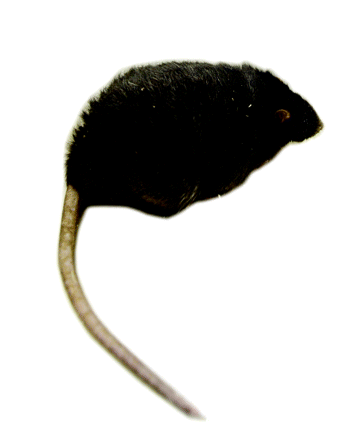Prospects for an Anti-Ghrelin Vaccine to Treat Obesity
The obesity pandemic is one of the leading health problems worldwide (Box 1). Understanding the neuroendocrine mechanisms that regulate body weight is an important research priority because such insight could guide the rational design of novel agents to treat obesity. Therapeutic strategies that are under active investigation include stimulating anorexigenic pathways, inhibiting orexigenic pathways, and increasing energy expenditure. The latter two approaches are exemplified by efforts to inhibit the effects of ghrelin, the only known orexigenic hormone (1). Ghrelin is thought to contribute to mealtime hunger, and considerable evidence suggests that it also participates in long-term body-weight regulation, possibly acting as an orexigenic counterpart to leptin and insulin in this regard (2). The relative importance of ghrelin in overall energy homeostasis is debated, however, because pharmacologic and genetic interventions to block ghrelin signaling have yielded varying effects on body weight in animals (3–14). Whether blockade of ghrelin action causes meaningful weight loss without eliciting malaise is probably the most important question in ghrelin research. In a recent publication from the Proceedings of the National Academy of Sciences, Zorilla and colleagues addressed this question using the novel approach of vaccinating rats against their own endogenous ghrelin (15). Animals that developed high ghrelin-specific antibody titers displayed less weight gain than did those with low or negative titers, despite showing no differences in food intake.
Definition of Obesity
Obesity is defined as having a body mass index (BMI) of greater than or equal to 30. Persons with a BMI between 25 and 29.9 are considered overweight. BMI is calculated using weight and height (kg/m2 or lbs/in2 x 703). It describes body weight normalized for height and is used as a screening tool to categorize degrees of body weight disturbance. Because BMI correlates well with direct measurements of body fat, it represents a quick and reliable indicator of this important trait. Variations in BMI occur as a function of gender, age, and ethnicity, so these factors should be taken into consideration.
Ghrelin, a peptide produced primarily by the stomach, powerfully increases food intake when administered to multiple species, including humans (1–3, 16, 17). The N terminus undergoes a unique post-translational modification in which the third serine residue is acylated with a medium chain–length fatty acid, typically octanoic acid, a process that is required for bioactivity pertaining to food intake (2, 16). Ghrelin is implicated in mealtime hunger and meal initiation, in part because circulating levels surge shortly before meals, and exogenous administration increases the number (but not size) of meals, while also stimulating numerous appetitive feeding behaviors in animals (e.g., sniffing, foraging, and hoarding food) (18, 19). Beyond this potential role to influence the timing of individual meals, ghrelin may also fulfill established criteria for an adiposity-associated hormone that, like leptin and insulin, informs the brain about the status of peripheral energy stores and contributes to long-term body-weight regulation (2). For example, ghrelin concentrations display compensatory responses to changes in body weight, rising with weight loss and vice versa. Ghrelin enters selected brain areas and acts through its receptor to modulate neuronal activity in classical centers of bodyweight regulation, including the hypothalamus, caudal brainstem, and mesolimbic reward centers. Ghrelin injections in any of these sites potently stimulate food intake. Chronic or repeated ghrelin administration increases body weight in experimental animals and humans, through anabolic effects on numerous aspects of energy intake, energy expenditure, and fuel utilization (2).
The final criterion that ghrelin should fulfill to qualify as a participant in body-weight regulation is that chronic blockade of its signaling should decrease body weight. Extant data regarding this important criterion are mixed (3–14). Congenital deletions of the gene for either ghrelin or its receptor yield very subtle phenotypic disturbances, with mutant mice displaying resistance to high-fat diet–induced obesity but no distinct changes in body weight when fed standard chow (8–12). However, developmental adaptations to the lifelong absence of ghrelin signaling could engage compensatory neuroendocrine pathways that might mask the true importance of ghrelin in energy homeostasis. Consistent with this possibility, reductions in food intake and body weight have been reported among adult animals subjected to pharmacologic blockade of ghrelin signaling by several different techniques, including the following: administration of ghrelin-specific antibodies into the brain (3–5); high doses of low-potency ghrelin receptor antagonists (7); antisense oligonucleotides directed against the ghrelin receptor mRNA (6); and ghrelin-blocking RNA Spiegelmers [i.e., nuclease-resistant (thus increasing bioavailable half-life) aptamer nucleotide sequences designed to bind specific proteins] (14). Many of these approaches are subject to criticism, however, because the specificity of their effects has not been proven, and/or potentially toxic anorectic consequences have not been fully ruled out. Thus, the impact on body weight of selectively blocking ghrelin signaling in adults remains controversial. Because of this uncertainty, the relative importance of ghrelin in overall energy homeostasis is also questioned, as is its promise as an anti-obesity drug target.
Utilizing a novel method to block ghrelin action with an anti-ghrelin vaccine, Zorilla et al. provide new evidence suggesting that ghrelin does, indeed, significantly contribute to body-weight regulation (15). To cause rats to mount an immune response against their own ghrelin, Zorilla et al. used rat ghrelin as a hapten and linked it to a large, immunogenic carrier molecule, keyhole limpet hemocyanin (KLH). Normal-weight male rats were vaccinated against full-length ghrelin, partial-length ghrelin, or KLH alone. Animals in each group generated antibodies against the immunoconjugate with which they were vaccinated, but, as expected, only those immunized against either acylated full-length ghrelin or an N-terminal fragment generated putatively immunoneutralizing antibodies against the bioactive N-terminal domain. (These are hereafter referred to as “ghrelin-specific antibodies”.) After one week of ad-libitum feeding on a low-energy, low-fat diet, rats with high titers of ghrelin-specific antibodies gained less weight, had less body fat, and had lower leptin levels than did those with low or negative ghrelin-specific titers. These differences in body weight occurred even though there were no differences in daily food intake between low- and high-titer animals. Thus, rats with high ghrelin-specific antibodies had low feed efficiency––defined as the amount of body weight gained per calorie ingested––suggesting that they had a higher metabolic rate. Feed efficiency was reduced roughly in proportion to the titer of ghrelin-specific antibodies. There were no differences in circulating levels of inflammatory markers [interleukin (IL)-1ß, IL-6, tumor necrosis factor–β, monocyte chemotactic protein-1, and plasminogen activator inhibitor-1], implying that the vaccine did not decrease weight gain by causing non-specific inflammation. The authors concluded that vaccination against endogenous ghrelin restrained body weight, not by altering food intake but by increasing metabolic rate.

Although these observations are promising, several limitations of this study should be noted. First, the vaccine caused no apparent change in aggregate daily food intake, but a difference might have been detected if this parameter were measured more frequently and with greater precision. Small changes in food intake can significantly alter body weight. Second, ghrelin’s effects on feeding are most impressive at increasing consumption of high-fat, palatable food, and when animals are given a choice of diets, they prefer high-fat food following ghrelin administration (20). Conversely, genetic ablation of ghrelin signaling reduces food intake and weight gain on high-fat diets but not on standard chow (11, 12). The rats in the current study were fed low-fat, less palatable food. It is possible that the authors would have observed an effect of ghrelin blockade on food intake if their study animals were fed high-fat food. A third caveat regarding Zorilla et al. pertains to their speculation that because rats with high ghrelin-specific antibody titers appeared to have decreased feed efficiency, they must have had increased metabolic rate. Metabolic rate was not actually measured, however, so the authors’ speculation needs to be verified empirically, for example by assessing oxygen consumption with indirect calorimetry. On the other hand, the hypothesis that blocking ghrelin action could increase metabolic rate is plausible because over-stimulation of ghrelin signaling leads to the opposite effect (i.e., a decrease in metabolic rate). Specifically, ghrelin administration decreases sympathetic nervous system output (21–23) and uncoupling-protein-1 expression in brown adipose tissue (24, 25), resulting in decreased oxygen consumption (26). Finally, relatively few rats were examined, and conclusions from this pilot study should be guarded, pending confirmation of the findings with larger numbers of subjects and in other species.
A major value of the current paper is that it provides evidence that blocking ghrelin signaling reduces weight gain in adult animals, in which early developmental adaptations cannot compensate for the lack of ghrelin signaling (15). Importantly, several observations argue against the possibility that the vaccine affected body weight through non-specific or toxic effects. For example, there were no abnormalities in energy homeostasis among vaccinated rats with low or absent ghrelin-specific antibody titers, and there was no evidence of inflammation. However, confirmation that the vaccine’s effects result specifically from blocking ghrelin, rather than from affecting other molecules, would require a demonstration that the method is ineffective in ghrelin-knockout animals. Further studies are also required to exclude the possibility that the weight-restraining effects of the vaccine might be caused by visceral illness, although the lack of an apparent reduction in food intake makes this possibility unlikely.
The technology used by Zorilla et al., in which the immune system is coerced into attacking an endogenous molecule, has possibly broad implications for medical research that extend far beyond ghrelin and bodyweight regulation. The ability to block a native target of one’s choosing could theoretically be deployed to remedy any condition of pathologic overproduction or to modulate selected biochemical pathways for medical purposes. Such techniques have been explored in attempts to create contraceptive vaccines, although results to date have been relatively disappointing. Active and passive vaccinations are also being developed to treat certain types of substance dependence in humans (27).
Several major concerns apply to the use of active vaccines directed against endogenous molecules. For example, it is not clear how the magnitude, kinetics, and duration of action of such immunopharmacotherapy can be controlled. Will anti-self vaccines be sufficiently efficacious and durable? Zorilla et al. only reported short-term results over a period of one week, and clearly, any viable anti-obesity vaccine would need to function for a much longer period of time. Conversely, and perhaps more importantly, could active vaccination against endogenous molecules sometimes prove overly effective? Unlike a typical receptor antagonist medication, which can be tapered or discontinued as needed, immunization is theoretically permanent. There is no obvious method to discontinue the process if it goes too far. Although, in the case of ghrelin, the absence of wasting phenotypes in knockout animals mitigates this concern, it remains a theoretical risk for the method in general. Moreover, for targets that are not fully characterized, the possibility that permanently inhibiting them might cause unexpected deleterious effects is a particularly concerning hazard when the intervention is not obviously reversible. Ghrelin, for example, has recently been shown to enhance learning and memory formation (28), and the long-term impact on cognitive function of hindering ghrelin signaling might prove consequential. There are also conceptual risks involved in immunizing against a target that is made continuously by the body, rather than against more traditional episodic infectious agents. We find that central blockade of ghrelin signaling elicits a marked compensatory increase in peripheral ghrelin concentrations, suggesting an autologous negative-feedback loop. An active ghrelin vaccine might render this same effect long-term, chronically hyper-stimulating secretion of ghrelin, which would continuously boost the anti-ghrelin humoral immune response. An endless cycle such as this could lead to pathologic complications from immune complex deposition (e.g., nephropathy).
Although concerns over the safety and efficacy of auto-vaccines persist, the work of Zorilla et al. constitutes an important step forward with a novel technology. Their data provide valuable loss-of-function evidence in adult animals favoring a significant role for ghrelin in body-weight regulation, thus increasing its promise as an anti-obesity target. More broadly, their results support the feasibility of developing vaccines directed against autologous entities, therapies that could theoretically be exploited for a host of medical purposes. Indeed, Cytos Biotechnology (Switzerland ) is currently developing vaccines against several endogenous molecules, and they have already begun testing an anti-ghrelin vaccine for weight loss in humans. It will be exciting to see whether the power of the immune system can safely be harnessed and unleashed as a targeted weapon to attack adversaries from within.
- © American Society for Pharmacology and Experimental Theraputics 2006
References

David E. Cummings, MD, is an Associate Professor in the Department of Medicine, Division of Metabolism, Endocrinology, and Nutrition, at the University of Washington, VA Puget Sound Health Care System, in Seattle. Address correspondence to DEC. E-mail davidec{at}u.washington.edu; fax 206-764-2689.

Molly J. Carlson, MD, is a Senior Fellow in the Department of Medicine, Division of Metabolism, Endocrinology and Nutrition, at the University of Washington, VA Puget Sound Health Care System, in Seattle. Her research focuses on the pathogenesis of obesity and the mechanisms of body weight regulation. E-mail mollyc{at}u.washington.edu; fax: 206-764-2689.



